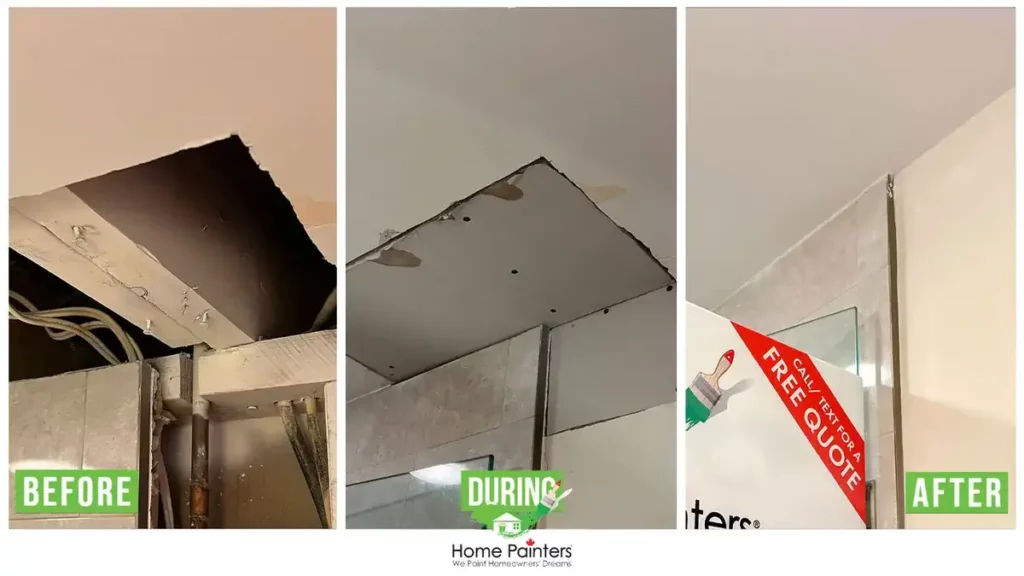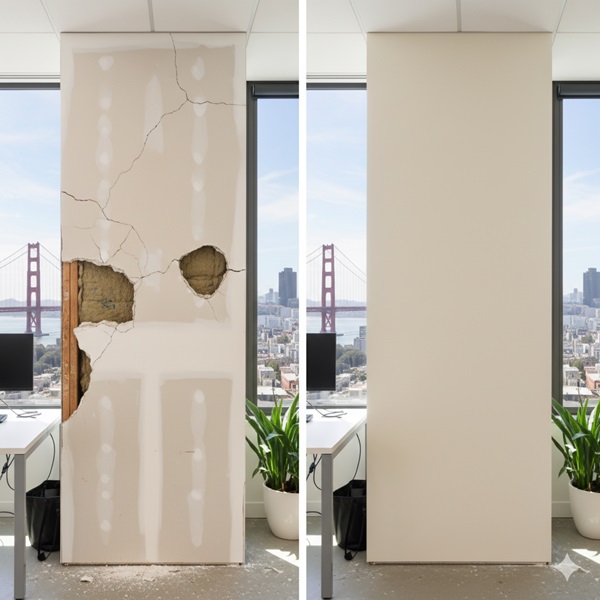Vital Tips for Effective Drywall Repair Service and Setup Techniques
Effective drywall repair work and setup calls for a mindful approach. Comprehending the kinds of drywall and having the right devices is crucial. Appropriate strategies and accurate measurements can considerably impact the outcome. Several forget essential actions like taping and sanding, which can make or break the last appearance. As projects advance, typical difficulties might occur that require attention. Exploring these tips can lead to an extra effective and polished coating.
Comprehending Different Kinds Of Drywall
Recognizing the various kinds of drywall is crucial for any effective repair service or setup task. Drywall, commonly called plaster board, comes in several selections customized for particular applications. Criterion drywall is the most extensively utilized kind, perfect for general interior walls and ceilings. Moisture-resistant drywall, frequently eco-friendly in shade, is developed for locations prone to humidity, such as kitchens and bathrooms. Fireproof drywall, typically tinted pink or purple, is engineered to withstand greater temperatures and is frequently made use of in garages or near heaters. Additionally, soundproof drywall aids reduce noise transmission, making it ideal for multi-family homes or tape-recording studios. Specialized drywall, like cement board, is utilized in wet areas like showers or bathtub surrounds. Recognizing these types assists in picking the right product for each task, making certain resilience and effectiveness in fixings or new installations.
Important Devices for Drywall Repair and Installation
Having the right tools is vital for efficient drywall fixing and installment. A top quality energy blade is vital for cutting drywall sheets exactly. A drywall T-square aids ensure straight edges, while a taping knife is required for applying joint substance efficiently over joints. In addition, a drywall saw permits cutting out harmed areas or suitable drywall around components.
For hanging drywall, a power drill with drywall screws is crucial, as it makes it possible for secure and fast installment. A degree is likewise crucial to verify that the drywall is straight and correctly lined up. Once it has dried, a sanding block or post sander is necessary for smoothing out joint compound. A gauging tape is vital for accurate measurements, protecting against waste and making certain an appropriate fit. Furnished with these tools, individuals can deal with drywall tasks successfully, resulting in professional-looking outcomes.
Step-by-Step Guide to Fixing Holes and Cracks
When dealing with openings and splits in drywall, having the right devices and materials is crucial for a successful repair work. This overview details the required things and gives a clear, step-by-step process to properly bring back the surface. Recognizing these aspects will certainly assist guarantee a smooth surface and durable outcomes.
Devices and Materials Needed
A well-appointed toolkit is important for reliable drywall repair work and setup. Secret tools include an utility blade for cutting drywall, a tape step to guarantee precise sizing, and a drywall saw for bigger openings. A putty knife is essential for applying joint compound efficiently, while a fining sand block or post sander helps accomplish a smooth finish. For patching, a roll of fiberglass fit together tape or paper tape is required to strengthen joints. In addition, a drill and screws are needed for securing new drywall pieces. Crucial products contain joint compound, guide, and paint to finish the fixing. Having these tools and products handy ensures a smoother, more efficient repair procedure, generating professional-looking results.
Fixing Refine Steps
Fixing openings and splits in drywall needs an organized strategy to assure a seamless coating. Initially, the area bordering the damages must be cleaned up extensively to remove dust and particles. Next off, for tiny splits, a putty blade is made use of to use a joint compound evenly over the area. For larger openings, a patch is needed; the damaged section is removed, and a brand-new piece of drywall is fitted in place, protected with screws. Once the spot remains in position, joint compound is used to blend the sides. After drying, fining sand the location smooth is important. Finally, the fixed surface must be keyed and repainted to match the bordering wall surface, making certain an inconspicuous repair service.
Techniques for Installing Drywall Panels
Setting up drywall panels needs careful preparation and exact execution to assure a specialist and smooth surface. First, it is crucial to measure the wall surface area properly and reduce the panels to fit, guaranteeing that they straighten with the studs. Placing the panels flat is generally suggested, as this can boost the structural stability and reduce the number of joints.
Making use of drywall screws, installers must secure the panels every 16 inches along the studs, making sure a firm hold. It is vital to stay clear of overdriving the screws, which can harm the paper surface area. For edges and corners, using an energy knife permits tidy cuts and a snug fit.

Finishing Touches: Taping, Mudding, and Fining sand
Once the drywall panels are safely in location, the following vital action entails the finishing touches of taping, mudding, and sanding. Insulation is necessary for developing a seamless shift in between panels and concealing joints. A blog here top quality drywall tape, either paper or fiberglass fit together, ought to be applied over the seams, ensuring it sticks correctly to the mud that will certainly be used next.
Mudding, or applying joint compound, follows the taping process. This compound loads spaces and ravel the surface. A first layer should be used generously, feathering the sides to blend with the drywall. After the initial layer dries, succeeding layers might be required for a flawless surface.
Finally, fining sand is necessary to achieve a smooth surface. A fine-grit sandpaper ought to be utilized to carefully smooth out any type of blemishes. Care must be required to stay clear of over-sanding, which can damage the drywall - drywall contractors. Effectively carried out, these finishing touches develop an expert look prepared for painting
Tips for Preserving Your Drywall After Installation
Keeping drywall after installment is crucial to maintaining its look and architectural stability. Normal cleansing is essential; dust and dirt can gather, so gentle wiping with a wet towel is recommended. House owners ought to additionally inspect for any type of indicators of moisture or mold, address particularly in high-humidity locations like kitchens and restrooms. If any kind of damages occurs, it is necessary to resolve it immediately to avoid further issues.
Making use of furniture pads can help prevent scrapes or damages from heavy things. Furthermore, repainting the drywall with a top quality, cleanable paint gives an additional layer of protection and makes future cleansing simpler. Avoid using abrasive cleansers or tools, as these can damage the surface. Preserving a stable indoor climate with appropriate humidity degrees will certainly assist stop cracking or warping over time. By following these ideas, one can assure that drywall continues to be in excellent condition for years ahead.
Regularly Asked Concerns
For How Long Does Drywall Take to Completely Dry After Installation?

Can I Set Up Drywall Over Existing Drywall?
Yes, drywall can be mounted over existing drywall, but it is important to ensure the underlying surface area is protected and adequately prepared. This technique can enhance insulation and lower setup time, though it might add weight.
What Is the very best Means to Soundproof Drywall?
The very best means to soundproof drywall includes using specialized soundproofing materials, such as durable channels, acoustic caulk, and sound-dampening drywall. These techniques successfully decrease sound transmission between rooms, boosting overall acoustic performance in living areas.
Just how Do I Pick the Right Drywall Density?
To choose the best drywall density, take into consideration the application and area. Requirement property wall surfaces generally use 1/2 inch, while ceilings or specialized locations might call for 5/8 inch for additional strength and soundproofing capacities.
Exist Eco-Friendly Drywall Options Available?
Yes, eco-friendly drywall alternatives are offered. These consist of items made from recycled products, gypsum boards with reduced volatile natural compounds (VOCs), and those using sustainable production processes, offering environmentally-conscious selections for construction and remodelling projects.
Having the right devices is vital for effective drywall repair service and installation. For hanging drywall, a power drill with drywall screws is vital, as it enables safe and quick setup. Trick devices include an utility knife for reducing drywall, a tape action to guarantee accurate sizing, and a drywall saw for bigger holes. Yes, drywall can be mounted over existing drywall, however it is essential to ensure the underlying surface is protected and properly prepared. The ideal way to soundproof drywall includes using specialized soundproofing materials, such as resilient networks, acoustic caulk, and sound-dampening drywall.